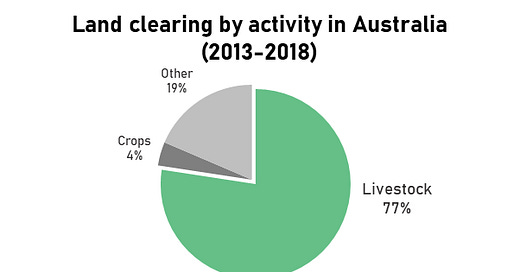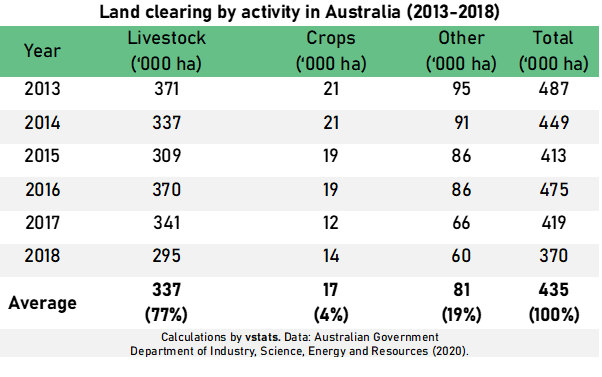Animal agriculture drives 77% of deforestation in Australia.
More than three-quarters of nationwide land clearing is for farming livestock animals.
‘Most forest land converted in Australia is used for cattle grazing…’
– Australian Government Department of Industry, Science, Energy and Resources.1
Australia is the only developed nation in the world to be designated among the global “deforestation fronts” by the WWF-World Wide Fund for Nature.2 Widespread land clearing threatens over a thousand native species3 and is a large emitter of greenhouse gases.4 However, few people are aware of what drives deforestation in this country: animal agriculture. Farming animals for food and fibre is responsible for more than three-quarters (77%) of land clearing nationwide (see Figure 1).
Figure 1. Land clearing by activity in Australia (2013-2018).
Official figures covering 2013 to 2018 available in Australia’s National Inventory Report5 and the Australian Greenhouse Emissions Information System6 reveal that each year an average of 337 thousand hectares of forest land – mostly native vegetation – were cleared to graze and intensively rear livestock (see Table 1).7 That amounts to 77% of the total land cleared in this period. Only 4% of land clearing took place to grow crops by comparison.8 All ‘other’ purposes combined, from plantations to mining to residential infrastructure, work out to 19%.9
Table 1. Land clearing by activity in Australia (2013-2018).
Australian Government Department of Industry, Science, Energy and Resources. (2020). National Inventory Report 2018: Volume 2. https://www.industry.gov.au/sites/default/files/2020-05/nga-national-inventory-report-2018-volume-2.pdf. See p. 10.
Cox, L. (2021, 13 January). Australia the only developed nation on world list of deforestation hotspots. The Guardian. https://www.theguardian.com/environment/2021/jan/13/australia-the-only-developed-nation-on-world-list-of-deforestation-hotspots
WWF – World Wide Fund for Nature and the International Institute for Applied Systems Analysis (IIASA). 2015. ‘Saving Forests at Risk’. In WWF Living Forests Report, eds. Rod Taylor. Gland, Switzerland: WWF –World Wide Fund for Nature. https://c402277.ssl.cf1.rackcdn.com/publications/793/files/original/Report.pdf?1430147305. See pp. 33-34.
Australian Government Climate Change Authority. (2018). Reaping the Rewards: Improving farm profitability, reducing emissions and conserving natural capital. https://www.climatechangeauthority.gov.au/sites/default/files/2020-06/2018%20Reaping%20the%20Rewards/Final%20Report%20-%20Reaping%20the%20Rewards.pdf. See p. 12.
Australian Government Department of Industry, Science, Energy and Resources. (2020). National Inventory Report 2018: Volume 2. https://www.industry.gov.au/sites/default/files/2020-05/nga-national-inventory-report-2018-volume-2.pdf. See pp. 275-276, table 6.L.2.
Australian Government Department of Industry, Science, Energy and Resources. (2021). Activity Table 1990-2018 – LULUCF [Datafile and codebook]. Australian Greenhouse Emissions Information System. https://ageis.climatechange.gov.au/QueryAppendixTable.aspx. See Table 2.
Land clearing for ‘livestock’ covers primary conversion and re-clearing for the following activities: grazing native vegetation, grazing modified pastures, grazing irrigated modified pastures, and intensive animal production.
Land clearing for ‘crops’ covers primary conversion and re-clearing for the following activities: cropping, perennial horticulture, seasonal horticulture, production from irrigated agriculture and plantations, irrigated cropping, irrigated perennial horticulture, irrigated seasonal horticulture, and intensive horticulture.
Land clearing for ‘other’ purposes covers primary conversion and re-clearing for all activities listed in the activity table that are not included in the ‘livestock’ and ‘crops’ categories detailed in notes [7] and [8].






